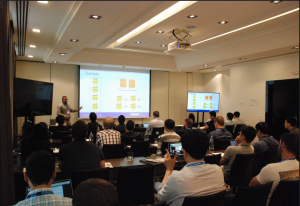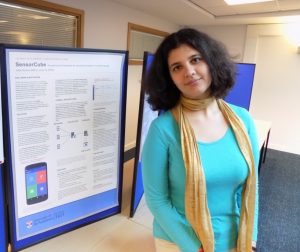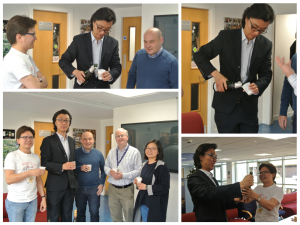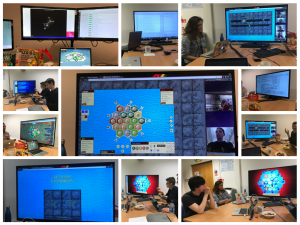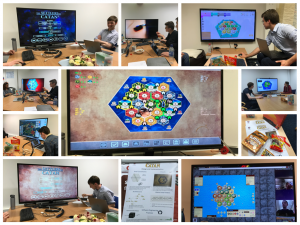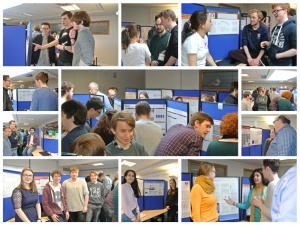At the Cyber Academy’s International Conference on Big Data in Cyber Security on May 10 2017 at Edinburgh Napier’s Craiglockhart Campus, PhD student Haifa Al Nasseri won two 3rd prizes. One was for her research poster on Cloud Virtual Network Isolation Security and the other was for her team’s efforts in the Splunk Hackathon.
Best Final Year Student at Lovelace 2017
We are delighted to congratulate Iveta Dulova, who attended the 10th BCSWomen Lovelace Colloquium, and walked away with the prize for “Best Final Year Student”. Iveta’s poster, titled “SensorCube: An end-to-end framework for conducting research via mobile sensing“, was based on her final year project supervised by Dr Juan Ye.
The event was held at Aberystwyth University on April 12, 2017. Also attending from St Andrews were Chloe Collins, competing in the second year category with the poster “Pedal to the metal – the role of technology in transportation” and Laura Brewis with her poster “What percentage of solitaire games are actually winnable?”.

 It showed great commitment for these three students to undertake the lengthy trip at a busy time of semester. Like St Andrews, Aberystwyth, is a beautiful small seaside town with an excellent Computer Science department. Iveta took a couple of photos showing off the beach and the campus.
It showed great commitment for these three students to undertake the lengthy trip at a busy time of semester. Like St Andrews, Aberystwyth, is a beautiful small seaside town with an excellent Computer Science department. Iveta took a couple of photos showing off the beach and the campus.
SRG Seminar: Investigation of Virtual Network Isolation Security in Cloud Computing Using Penetration Testing by Haifa Al Nasseri
Software Defined Networking (SDN) or Virtual Networks (VNs) are required for cloud tenants to leverage demands. However, multi-tenancy can be compromised without proper isolation. Much research has been conducted into VN Isolation; many researchers are not tackling security aspects or checking if their isolation evaluation is complete. Therefore, data leakage is a major security concern in the cloud in general.

This research uses an OpenStack VN and OpenStack Tenant Network to test multi-tenancy features. We are evaluating the relationship between isolation methods used in cloud VN and the amount of data being leaked through using penetration tests. These tests will be used to identify the vulnerabilities causing cloud VN data leakage and to investigate how the vulnerabilities, and the leaked data, can compromise the tenant Virtual Networks.
Event details
- When: 4th May 2017 13:00 - 14:00
- Where: Cole 1.33b
- Series: Systems Seminars Series
- Format: Talk
PhD viva success: Yuchen Zhao
Congratulations to Yuchen, who successfully defended his thesis yesterday. He is pictured with supervisors Dr Tristan Henderson and Dr Juan Ye, Internal examiner Professor Simon Dobson and external examiner Dr Mirco Musolesi, from UCL.
Workshop on Considering Technology through a Philosophical Lens
 Technology fundamentally shapes our communication, relationships, and access to information. It also evolves through our interaction with it. Dialoguing across disciplines can facilitate an understanding of these complex and reciprocal relationships and fuel reflection and innovation.
Technology fundamentally shapes our communication, relationships, and access to information. It also evolves through our interaction with it. Dialoguing across disciplines can facilitate an understanding of these complex and reciprocal relationships and fuel reflection and innovation.
This hands-on, participant-driven and experimental workshop will start a discussion of what can come from considering technology through a philosophical lens. Through discussions and hands-on design activities, it will provide an introduction to and reflection on questions at the intersection of computer science and philosophy, such as:
- How have philosophy and technology shaped each other in the past?
- How can philosophical ideas and methods guide research in Computer Science?
- How can thinking through technology help Humanities researchers discover relevance and articulate impact in their research?
Engaging these questions can provide participants an entry-point into exploring these themes in the context of their own research.
This workshop is aimed at researchers from computer science who are curious about philosophy and how to leverage it to inform technically oriented research questions and designing for innovation. It is also aimed at researchers in the arts & humanities, social sciences, and philosophy who are curious about current research questions and approaches in computer science and how questions of technology can stimulate philosophical thought and research.
Attending the workshop is free but please register by emailing Nick Daly: nd40[at]st-andrews.ac.uk
Organisers: Nick Daly (School of Modern Languages) and Uta Hinrichs (School of Computer Science)
Event details
- When: 18th May 2017 10:00 - 13:00
- Where: Cole 1.33a
- Format: Workshop
Alex Bain completes 2017 London Marathon
Congratulations to School Manager Alex Bain, who completed the London Marathon again this year, raising funds for Guide Dogs. Alex, runner no 40807 is pictured below with his finisher’s medal. Donations to recognise his achievement and the training involved, can be made via his Justgiving page. Read more about his fundraising on KingdomFM.
MPhil viva sucess: Yunjia Wang
Congratulations to Yunjia Wang, who successfully defended his thesis today. He is pictured with Internal examiner Dr Alice Toniolo and Supervisor Dr Ishbel Duncan.
Junior Honours: Software Team Project 2017
Earlier today our Junior Honours students presented their Team Projects. The projects involve substantial team based software engineering and rely heavily on collaborative development. There are many aspects of software and professional development along with considerable inter-team and intra-team collaborations. This year the students were asked to develop a version of the Settlers of Catan with AI players. They were further asked to make their games interoperate so one teams AI or human player might play on another teams game and board.
The teams demonstrated lots of creativity with the use of software tools, approaches to AI, use of domain specific languages, remote services, games environments, graphics development, collaborative frameworks and many tools for software engineering project development. Thanks to all the students, supervisors and coordinators for their hard work this year.
We wish all our junior honours students success with their forthcoming exams and we look forward to seeing them again for their senior honours year in September.
Images and text courtesy of Professor Aaron Quigley
Senior Honours: Poster Presentation and Demo Session 2017
Our talented hard working SH students from CS4099: Major Software Project and CS4098: Minor Software Project presented their posters and final year software artifact to staff and students earlier this week.
As Illustrated in the above collage, the busy poster session is the perfect opportunity to discuss output from their year long project with markers, and provides time to share research ideas and reflect on the experience with their peer group. We wish them success with forthcoming exams and look forward to seeing them during June graduation celebrations.
SRG at IEEE CCGrid 2017
Congratulations to Uchechukwu Awada, who presented “Improving resource efficiency of container-instance clusters on clouds” at the 17th IEEE/ACM International Symposium on Cluster, Cloud and Grid Computing.
